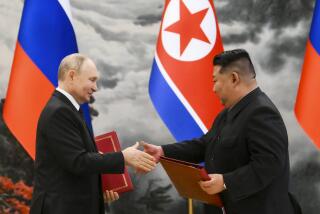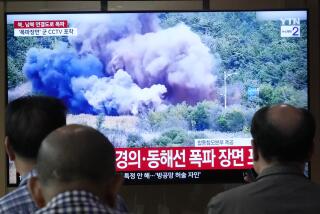Nuclear Effort Warming Ties for 2 Koreas
- Share via
KUMHO, North Korea — Rusting boats and stilled cranes line the piers of the dilapidated port of Yanghwa on North Korea’s remote northeastern coast.
The clothing and umbrellas of the few people on the dock are drab. The red paint on the party slogans atop the somber concrete warehouses is faded. The only bright, well-maintained object in sight is a huge portrait of “Great Leader” Kim Il Sung, who died three years ago.
The isolation, time warp and ideology gap are daunting to some of the 67 South Korean construction workers and engineers who have set up shop here. In an experiment in constructive engagement, they are to build two nuclear power plants for energy-starved North Korea, in exchange for Pyongyang’s freezing of its suspected nuclear weapons program.
The South Korean workers will spend at least a year in Kumho, where they have found themselves inside a hermetically sealed enclave inside an already hermetic, xenophobic North Korea. Contact with the locals is limited to those who work in the Soviet-style guest house near the reactor site or on the reactor itself.
When the outsiders are driven anywhere, “there are little guys with Volvos that go ahead of us on the road and shoo the people away so we’re exposed to the minimum number of people,” one diplomatic source said. “There’s nothing secret about [the project] . . . but I think the North Koreans want to keep [it] a secret from their own people.”
The foreigners--here with a handful of South Korean, American and Japanese officials working with the Korean Peninsula Energy Development Organization, or KEDO--did see one program about KEDO on the sole North Korean television station, which usually features singing soldiers, old war movies and traditional dramas. And those here who were involved in negotiating the project report unanimously that relations with their North Korean counterparts are steadily improving.
Still, jogging through the sandy pine forests here is not permitted, and foreigners must be escorted to swim or dig for clams in the ocean. The beach is cut off from the reactor site by a large, sandy berm, apparently fortified to protect against an invasion.
*
The concrete housing used by the foreigners was originally built for Soviet workers who were once expected to build a reactor here, and it has hot water for only two hours a day. But living conditions are expected to improve once the South Koreans build a new dormitory and recreation center, complete with billiard halls, karaoke parlors and satellite TV.
Park Young Chul, the South Korean director of the construction division of Korean Electric Power Corp., the main KEDO contractor, called Kumho “a big jail without a fence.” Nevertheless, he plans to spend two years here, joining his family in South Korea only once every three months. “I am worried about divorce,” he confided.
But in one sign of how KEDO is bringing change, however modest, Park can now call his wife in Seoul on special telephone lines that connect Kumho to South Korea. The two Koreas have had no direct telephone lines and little contact, except along the demilitarized zone between the two countries, since the Korean War ended in 1953.
Despite the North’s Stalinist regime and visceral mistrust of the capitalist world, there are signs that Pyongyang is reaching out to the international community, using the KEDO project as a trial run. One such signal was the unprecedented invitation to more than 100 officials, journalists and diplomats from nine countries and the European Union to attend the groundbreaking at the reactor site Tuesday and to broadcast the ceremony.
More surprising, South Korean and Japanese diplomats were permitted to deliver speeches--although about 40 North Korean bureaucrats in the audience appeared to be confused about whether or not they were supposed to applaud their ideological-enemies-turned-partners. Some clapped politely, while others sat motionless and still others swiveled around to see what their colleagues were doing.
Another indicator of North Korea’s willingness--perhaps only tactical--to reduce its international isolation is the announcement Friday that the regime will allow some of its Japanese residents to return to Japan for the first time in decades. The concession was aimed at clearing the way for eventual resumption of diplomatic relations with Japan.
During the well-scripted visit to Kumho, North Korea’s dire poverty could not be disguised. An oxcart lumbered through the port, and the only motor vehicles in sight were for visitors. Workers trying to improve the muddy road that winds from the port up to the reactor site were toiling with only buckets and shovels.
*
A man trudged down the railroad tracks hauling a wagon heavily loaded with cloth sacks and a passenger perched on top. Thin people in old clothes peered from a rusty, slow-moving train that looked all but empty.
The foreigners at the site said that in their highly circumscribed movements, they have seen no evidence of malnutrition in Kumho, and there were few signs of the drought that South Korean officials estimate has affected a third of the North’s farmland.
Kumho’s hills and fields were green, cows and goats grazed, the backyards of the tile-roofed homes were thickly planted with vegetables, beans, corn and vines. Lush pear orchards and rice paddies looked nearly ready for harvest.
But receding water in a lake has left a pumping station high and dry above mud flats, and North Korean and U.S. officials said the drought in the Kumho area has stunted crops.
Despite the crisis, foreigners in Kumho said they have observed no signs that the totalitarian regime is teetering--or that North Koreans’ mantra-like professions of loyalty to the late Kim Il Sung and his son, “Dear Leader” Kim Jong Il, are anything other than sincere.
One North Korean official explained why he continues to wear a red Kim Il Sung button--not a Kim Jong Il button--on his left breast.
“We all wanted to wear Kim Jong Il buttons, but Kim Jong Il refused to have them made,” he said. “He told the people that in our hearts, Kim Il Sung will always be our father.”
More to Read
Sign up for Essential California
The most important California stories and recommendations in your inbox every morning.
You may occasionally receive promotional content from the Los Angeles Times.













